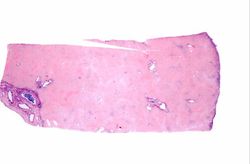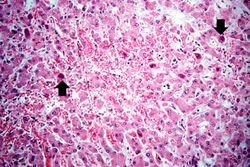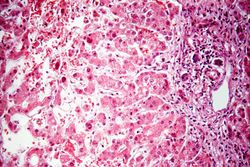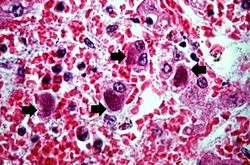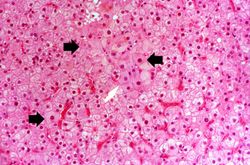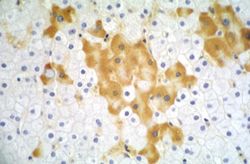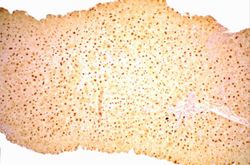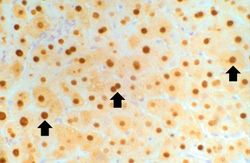Difference between revisions of "IPLab:Lab 8:Hepatitis B"
Seung Park (talk | contribs) (→Images) |
Seung Park (talk | contribs) |
||
| Line 20: | Line 20: | ||
File:IPLab8HBV10.jpg|This high-power photomicrograph of the previous section shows the HBcAg positive nuclei (arrows). | File:IPLab8HBV10.jpg|This high-power photomicrograph of the previous section shows the HBcAg positive nuclei (arrows). | ||
</gallery> | </gallery> | ||
| + | |||
| + | == Virtual Microscopy == | ||
| + | <peir-vm>IPLab8HBV</peir-vm> | ||
== Study Questions == | == Study Questions == | ||
Latest revision as of 16:29, 3 January 2014
Contents
Clinical Summary[edit]
This was a 55-year-old white male with chronic renal failure who acquired hepatitis B virus (HBV) in a renal dialysis unit. Death was the result of multiple disease processes, which included active pulmonary tuberculosis and heart failure due to ischemic heart disease. There were few or no symptoms or signs of hepatitis during life other than seroconversion from negative to HBsAg positive.
Autopsy Findings[edit]
At autopsy, the liver was enlarged due primarily to severe passive congestion.
Images[edit]
This is a low-power photomicrograph of liver from this case. This section was stained with a modified aldehyde fuchsin and counterstained with hematoxylin and eosin. Modified aldehyde fuchsin colors cystine-rich proteins--such as HBsAg and elastic fibers--deep purple. The cytoplasm of most liver cells (and RBCs) stain red due to the eosin and have dark blue nuclei.
Virtual Microscopy[edit]
Study Questions[edit]
Additional Resources[edit]
Reference[edit]
- eMedicine Medical Library: Hepatitis B
- Merck Manual: Acute Viral Hepatitis
- Merck Manual: Neonatal Hepatitis B Virus Infection
Journal Articles[edit]
- Merle P, Trepo C. Therapeutic management of hepatitis B-related cirrhosis. J Viral Hepat 2001 Nov;8(6):391-9.
Images[edit]
Related IPLab Cases[edit]
| |||||
Renal failure is the severe reduction of renal function and often leads to reduced urinary output.
Cirrhosis is a liver disease characterized by necrosis, fibrosis, loss of normal liver architecture, and hyperplastic nodules.
The normal fibrinogen level is 184 to 412 mg/dL.
